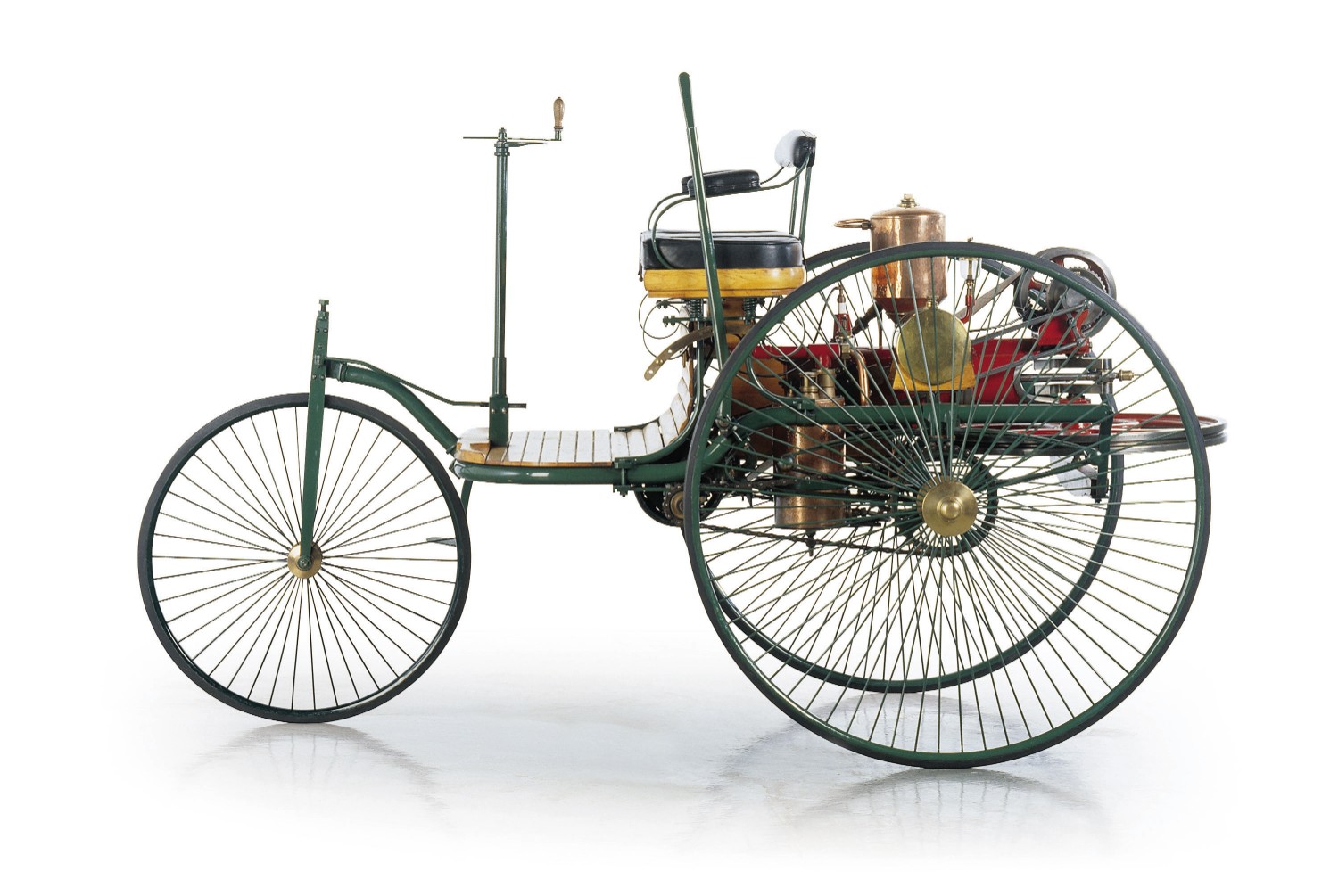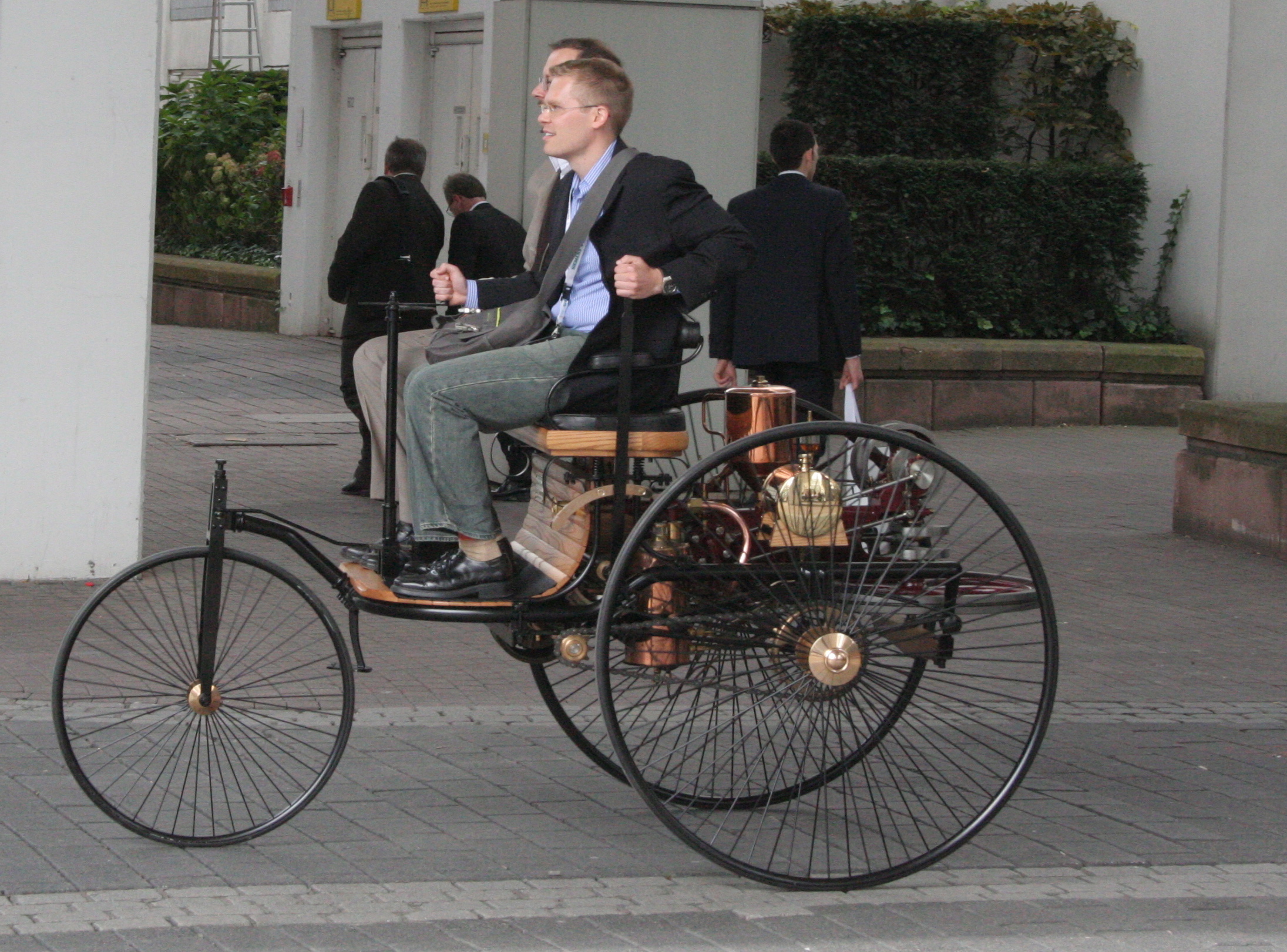Benz Patent-Motorwagen on:
[Wikipedia]
[Google]
[Amazon]
The Benz Patent-Motorwagen ("patent motorcar"), built in 1885 by the German Carl Benz, is widely regarded as the world's first practical modern
 The Benz Patent-Motorwagen was a motor tricycle with a rear-mounted engine. The vehicle contained many new inventions. It was constructed of steel tubing with woodwork panels. The steel-spoked wheels and solid rubber tires were Benz's own design. Steering was by way of a toothed rack that pivoted the unsprung front wheel. Fully elliptic
The Benz Patent-Motorwagen was a motor tricycle with a rear-mounted engine. The vehicle contained many new inventions. It was constructed of steel tubing with woodwork panels. The steel-spoked wheels and solid rubber tires were Benz's own design. Steering was by way of a toothed rack that pivoted the unsprung front wheel. Fully elliptic 

 In Germany, a parade of antique automobiles celebrates this historic trip of Bertha Benz every two years. On February 25, 2008, the Bertha Benz Memorial Route,
In Germany, a parade of antique automobiles celebrates this historic trip of Bertha Benz every two years. On February 25, 2008, the Bertha Benz Memorial Route,Bertha Benz Memorial Route
(German-government-approved non-profit official site) following the route of Benz's journey, was officially approved as a Tourist or Scenic Route by the German authorities as a route of industrial heritage of mankind. The of signposted route leads from Mannheim via Heidelberg to Pforzheim (
 The car can be driven in the video game '' Gran Turismo 4'' and
The car can be driven in the video game '' Gran Turismo 4'' and
Driving Legends: The Car Story
'. It was also driven by Sherlock Holmes's sister Enola in the film '' Enola Holmes''.
Automuseum Dr. Carl Benz, Ladenburg (Heidelberg)
{{Authority control Patent-Motorwagen First car made by manufacturer Three-wheeled motor vehicles 1880s cars 1890s cars German inventions Vehicles introduced in 1886 Cars introduced in 1886 1886 in Germany
automobile
A car or automobile is a motor vehicle with wheels. Most definitions of ''cars'' say that they run primarily on roads, seat one to eight people, have four wheels, and mainly transport people instead of goods.
The year 1886 is regarded ...
and was the first car put into series production. It was patented and unveiled in 1886. The original cost of the vehicle in 1886 was 600 imperial German marks, approximately 150 US dollars ().
Karl's wife Bertha demonstrated its feasibility in a trip from Mannheim to Pforzheim in August 1888, shortly before it became the first commercially available automobile in history in the late summer of 1888.
Due to the creation of the Patent-Motorwagen, Benz has been hailed as the father and inventor of the automobile.
Development and specifications
After developing a successfulgasoline
Gasoline (; ) or petrol (; ) (see ) is a transparent, petroleum-derived flammable liquid that is used primarily as a fuel in most spark-ignited internal combustion engines (also known as petrol engines). It consists mostly of organic ...
-powered two-stroke piston engine in 1873, Benz focused on developing a motorized vehicle while maintaining a career as a designer and manufacturer of stationary engines and their associated parts.
 The Benz Patent-Motorwagen was a motor tricycle with a rear-mounted engine. The vehicle contained many new inventions. It was constructed of steel tubing with woodwork panels. The steel-spoked wheels and solid rubber tires were Benz's own design. Steering was by way of a toothed rack that pivoted the unsprung front wheel. Fully elliptic
The Benz Patent-Motorwagen was a motor tricycle with a rear-mounted engine. The vehicle contained many new inventions. It was constructed of steel tubing with woodwork panels. The steel-spoked wheels and solid rubber tires were Benz's own design. Steering was by way of a toothed rack that pivoted the unsprung front wheel. Fully elliptic springs
Spring(s) may refer to:
Common uses
* Spring (season), a season of the year
* Spring (device), a mechanical device that stores energy
* Spring (hydrology), a natural source of water
* Spring (mathematics), a geometric surface in the shape of a he ...
were used at the back along with a beam axle and chain drive on both sides. A simple belt system served as a single-speed transmission, varying torque between an open disc and drive disc.
The first Motorwagen used the Benz single-cylinder four-stroke
A four-stroke (also four-cycle) engine is an internal combustion (IC) engine in which the piston completes four separate strokes while turning the crankshaft. A stroke refers to the full travel of the piston along the cylinder, in either direct ...
engine with trembler coil ignition. This new engine produced at 250 rpm in the Patent-Motorwagen, although later tests by the University of Mannheim showed it to be capable of at 400 rpm. It was an extremely light engine for the time, weighing about . Although its open crankcase and drip oiling system would be alien to a modern mechanic, its use of a pushrod-operated poppet valve
A poppet valve (also called mushroom valve) is a valve typically used to control the timing and quantity of gas or vapor flow into an engine.
It consists of a hole or open-ended chamber, usually round or oval in cross-section, and a plug, usual ...
for exhaust would be quite familiar. A large horizontal flywheel stabilized the single-cylinder engine's power output. An evaporative carburettor was controlled by a sleeve valve to regulate power and engine speed. The first model of the Motorwagen had not been built with a carburettor, rather a basin of fuel soaked fibers that supplied fuel to the cylinder by evaporation.
The vehicle was awarded the German patent
A patent is a type of intellectual property that gives its owner the legal right to exclude others from making, using, or selling an invention for a limited period of time in exchange for publishing an sufficiency of disclosure, enabling disclo ...
number 37435, for which Karl Benz applied on 29 January 1886. Following official procedures, the date of the application became the patent date for the invention once the patent was granted, which occurred in November of that year. Benz unveiled his invention to the public on 3 July 1886, on the Ringstrasse in Mannheim.
Benz later made more models of the Motorwagen: model number 2 had engine, and model number 3 had engine, allowing the vehicle to reach a maximum speed of approximately . The chassis was improved in 1887 with the introduction of wooden-spoke wheels, a fuel tank, and a manual leather shoe brake on the rear wheels.
About 25 Patent-Motorwagen were built between 1886 and 1893.


Bertha Benz's trip
Bertha Benz
Bertha Benz (; ; 3 May 1849 – 5 May 1944) was a German automotive pioneer and inventor. She was the business partner and wife of automobile inventor Carl Benz. On 5 August 1888, she was the first person to drive an internal-combustion-engined ...
, Karl's wife, whose dowry financed the development of the Patent-Motorwagen, was aware of the need for publicity. She took the Patent-Motorwagen No. 3 and drove it on the first long-distance internal combustion automobile road trip to demonstrate its feasibility. That trip occurred in early August 1888, when she took her sons Eugen and Richard, fifteen and fourteen years old, respectively, on a ride from Mannheim through Heidelberg, and Wiesloch, to her maternal hometown of Pforzheim.
 In Germany, a parade of antique automobiles celebrates this historic trip of Bertha Benz every two years. On February 25, 2008, the Bertha Benz Memorial Route,
In Germany, a parade of antique automobiles celebrates this historic trip of Bertha Benz every two years. On February 25, 2008, the Bertha Benz Memorial Route,(German-government-approved non-profit official site) following the route of Benz's journey, was officially approved as a Tourist or Scenic Route by the German authorities as a route of industrial heritage of mankind. The of signposted route leads from Mannheim via Heidelberg to Pforzheim (
Black Forest
The Black Forest (german: Schwarzwald ) is a large forested mountain range in the state of Baden-WĂĽrttemberg in southwest Germany, bounded by the Rhine Valley to the west and south and close to the borders with France and Switzerland. It is ...
) and back.
In media
 The car can be driven in the video game '' Gran Turismo 4'' and
The car can be driven in the video game '' Gran Turismo 4'' and Android
Android may refer to:
Science and technology
* Android (robot), a humanoid robot or synthetic organism designed to imitate a human
* Android (operating system), Google's mobile operating system
** Bugdroid, a Google mascot sometimes referred to ...
video game Driving Legends: The Car Story
'. It was also driven by Sherlock Holmes's sister Enola in the film '' Enola Holmes''.
See also
* History of the automobile * Benz Velo (later 4 wheel model) * List of Mercedes-Benz vehicles (incl. summary of Benz vehicles) * List of motorcycles of the 1890s * List of motorized trikes * Three-wheelerEarly developments essential to the development of automobiles
* Nicolas Léonard Sadi Carnot, physics of the internal combustion engine * Illuminating gas, first internal combustion engine fuel * Ligroin or heavy naphtha, first liquid automotive fuel, ''n''-hexaneCar and car engine designers, chronologically by first vehicle/engine built
* Nicolas-Joseph Cugnot (1725–1804), French inventor of the world's first automobile, a 1769–1770 steam-fuelled vehicle * Étienne Lenoir, developer of the first atmospheric gaseous fueled internal combustion engine and automobile (1860–1863), pioneer of electroplating * Nicolaus Otto, developer of the first successful compressed charge gaseous fueled internal combustion engine (1860s–70s) * Siegfried Marcus, developed petrol-powered, internal combustion engine vehicles (1864? 1870? 1888) *Wilhelm Maybach
Wilhelm Maybach (; 9 February 1846 – 29 December 1929) was an early German engine designer and industrialist. During the 1890s he was hailed in France, then the world centre for car production, as the "King of Designers".
From the late 19th ce ...
, designed engines starting in the 1870s–80s; first motorbike (1885), second internal combustion car (1889)
*Gottlieb Daimler
Gottlieb Wilhelm Daimler (; 17 March 1834 – 6 March 1900) was a German engineer, industrial designer and industrialist born in Schorndorf ( Kingdom of Württemberg, a federal state of the German Confederation), in what is now Germany. He wa ...
, German engineer, pioneer of internal-combustion engines and automobile development (1870s and on)
Notes
References
External links
* Patent 37435, by Karl Benz for his 1885 Motorwagon The birth certificate of the automobile - the German patent application of January 29, 1886, that was granted on November 2, 1886 to Benz & Company in MannheimAutomuseum Dr. Carl Benz, Ladenburg (Heidelberg)
{{Authority control Patent-Motorwagen First car made by manufacturer Three-wheeled motor vehicles 1880s cars 1890s cars German inventions Vehicles introduced in 1886 Cars introduced in 1886 1886 in Germany